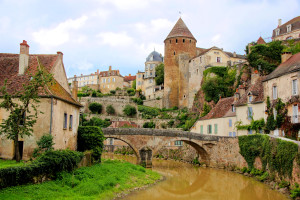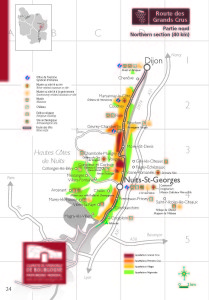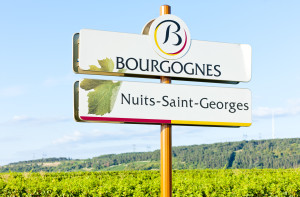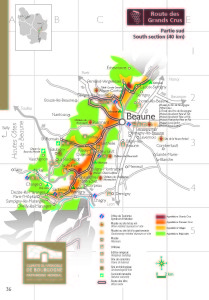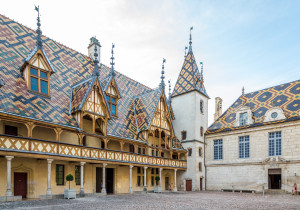Today we have a preview of a session to be presented during SWE’s 42nd Annual Conference, to be held on August 15–17, 2018 in the Finger Lakes Region of New York State. This preview is authored by Don Kinnan, CSS, CWE.
There is perhaps no vinous rivalry more intense and long-standing in Burgundy than that between Nuits-Saint-Georges and Beaune. Both villages serve as namesakes for their prominent wine districts, Côte de Nuits and Côte de Beaune. Both are major wine producing villages with highly rated vineyards in the respected Burgundy wine classification hierarchy. Within Burgundy’s hallowed Côte d’Or, no other villages can match the number of premier cru vineyard climats of Nuits (41) and Beaune (42).
During the SWE Conference in August, 2018, a courtroom format will be used to present the two villages’ cases for supremacy. Some of that evidence is included below just to stimulate your unquenchable thirst for knowledge. However, during the live presentation in August, be prepared for some surprises as certain facts may be challenged, objections will be made and ruled upon, and the jury (the audience) will give its verdict.
Nuits-Saint-Georges
Nuits-Saint-Georges sits at the southern end of the famous Côte de Nuits, Burgundy’s most acclaimed red wine producing district. The reputation of the Côte de Nuits’ wine quality is firmly based upon its superlative “terroirs”. Complex Middle Jurassic limestone-infused marls have been shuffled like cards in a deck of cards to create indelible stamps of individuality and potential greatness in Côte de Nuits red wines. The hand of the winemaker is sparingly and gently applied, so as not to disturb the subtle “terroir” signature of the wine’s growing site.
Nuits-Saint-Georges is blessed with tremendous diversity and wealth within its Middle Jurassic soil packages as attested to by its award of 41 premiers crus under Burgundy’s classification system. With a vineyard area that stretches nearly 4 miles, longer than any other Côte d’Or village, Nuits has 3 major “terroir” packages within its boundaries.
The vineyard area north of the village proper, sometimes referred to as Côte Vosne (because of its proximity to Vosne-Romanée), tends to produce wines of greater elegance and finesse than Nuits’ other sectors.
The middle section of vineyards, just south of the town, is considered the best part of the commune. Here one finds the very esteemed premiers crus, Les Saint-Georges, Les Cailles, and Les Vaucrains, all candidates for Grand Cru status.
Finally, further south, in the village of Premeaux, lies Nuits’ third vineyard sector. Here, the soil is shallower, the slope steeper, and the Jurassic layers beginning to transition to those most commonly found in the Côte de Beaune. As a result, the normally richer, sturdier style of Nuits wine becomes more austere, a little rough around the edges, and maybe with a touch of the maverick.
The wines of Nuits have a long history of fame and royal patronage. Most notable is King Louis XIV’s conversion to Nuits wine at the recommendation of his personal physician, Monsieur Guy-Crescent Fagon in 1698 AD. After taking his doctor’s advice, the king, who had been ill, returned to good health. More recently, in 1971, the wine of Nuits-Saint-Georges became enshrined on Earth’s moon when the Apollo 15 astronauts named the crater at their landing site, “St-George” in honor of Nuits-Saint-Georges wine. Later that year, the Apollo 15 astronauts visited the town of Nuits and were made honorary citizens.
Like Beaune, Nuits is a commercial center, as well as, a wine village. Population-wise, Nuits, with approximately 5,500 residents, is about one fourth the size of Beaune. It does sit astride the major autoroute from Paris and serves as a center for wine shippers, brokers, negociants, cooperages, crémant producers, liqueur makers, and other service industries. Just as Beaune has its Hospices de Beaune, Nuits has its Hospices de Nuits, a charitable organization founded in 1692 AD and devoted to the support of local hospitals.
The ultimate test of wine supremacy, especially in Burgundy, rests with the demonstrated excellence of the growing sites or “terroirs”. In the hands of respectful “caretakers”, wine produced from these sites will translate into original and universally admired wine, vintage after vintage. Nuits-Saint-Georges has clearly demonstrated this trait ever since the monks began to produce wine from their Clos St-Georges vineyard in 1093 AD.
However, you be the judge. Come to the SWE Conference in 2018, attend this session, and taste the wines for yourself. Then decide who is supreme—Nuits-Saint-Georges or Beaune.
Beaune
Beaune is the historic center of Burgundy’s wine trade. Many of the major wine merchant houses are headquartered there, such as, Louis Jadot, Louis Latour, Bouchard Pere et Fils, Champy, and Joseph Drouhin. Most of these firms have cellars under the streets of this ancient walled town. Beaune’s origin goes back to 40 A. D. when it was a Roman settlement lying astride the main access roads into the heart of Gaul. Today, with a population of 23,000, it is Burgundy’s largest commercial center and annually hosts the famous wine auction of the Hospices de Beaune.
The vineyards of Beaune appear as majestic as the town itself. Most of the vineyards are arrayed on a looming slope just to the west of the town. This is where the 42 premier cru sites are found. Beaune has more premiers crus than any other village appellation in the Côte d’Or, a true testimony to its superb “terroir”. The slope is fairly contiguous and is generally southeast facing as it extends in a north-south direction. The relative uniformity of the slope, along with its exposure and geology, result in a similarity of wine style among the various premiers crus. However, though sometimes more discreet, distinctions and differences are there.
The premier cru slope is normally discussed by dividing it into 3 sections, the north, the center, and the south. Soils are thinner in the north, possessing more gravel in the center, and with more limestone mixed with sand in the south. Mid-slope sites in the south become very stony, but lower down there is more clay and less gravel. There are also pockets of whitish marls which accommodate white grapes , especially in the Clos Des Mouches and Les Grèves premiers crus.
Beaune is the Côte d’Or’s second largest producing red wine village, just behind Gevrey-Chambertin. The wines of Beaune are internationally recognized for their approachability and value. They consistently display lovely perfumes and lively red fruits, with a finely-knitted gentle structure. Of course, there are many examples of more intense wine with substantial complexity and depth. We invite you to attend the SWE session at this year’s conference to discover the beauty and diversity of this wonderful appellation.
The session—Hear Ye! Hear Ye! Nuits vs Beaune—will be held on Thursday, August 17, 2018 at 1:15 pm as part of the 42nd Annual Conference of the Society of Wine Educators to be held in the Finger Lakes Region of New York State. The presenters will be Don Kinnan CSS, CWE; Nicholas Poletto CSS, CSW, DipWSET; and Missi Holle CSS, CWE, WSET III
